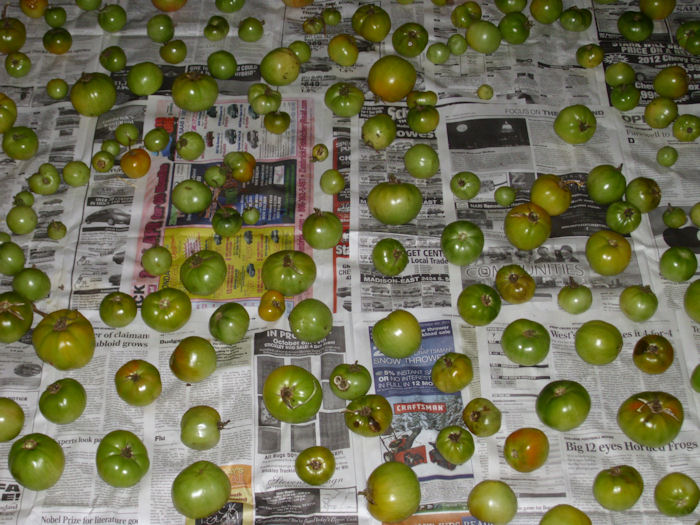One of the advantages of growing your own tomatoes is that you can pick them when they’re ripe—when the taste and nutritional value is at its peak. During the summer months you avoid “strip mined” tomatoes by picking selectively from the vine. However, the end of the season arrives all too soon and you’re faced with a wealth of green tomatoes. You have to do something with these tomatoes before a major frost or risk losing them. Tomato plants can keep producing new tomatoes right up to harvest.
It’s possible to use green tomatoes directly. For example, fried green tomatoes is a favorite of mine (albeit, not particularly nutritious depending on which recipe you use). Pickled tomatoes also look very interesting; although, I must admit not fixing them personally. The pickled tomatoes that I’ve tried have been delicious. In fact, there are many more ways to fix green tomatoes than you might initially think. However, even with all of these recipes, green tomatoes aren’t the epicurean delight that some people want.
Fortunately, you can ripen the tomatoes even after they’ve left the vine. I’ve tried a number of methods and found most of them lacking. For example, some books recommend pulling the entire plant out of the ground and hanging it in your garage. This method assumes that your garage won’t get to the freezing point before the tomatoes are ripe. Using this method can also result in a lot of spoilage from mold. It does have the advantage of producing tomatoes that taste almost as good as if they were vine ripened outside.
There are also methods that rely on placing the tomatoes in a jar with a banana peel (a technique I haven’t tried) and placing them in a paper bag. My parents would often ripen a few remaining tomatoes by placing them in the window sill. Unfortunately, most modern homes lack window sills and the method does have problems in that the tomatoes can ripen unevenly. The best method I’ve found for ripening a lot of green tomatoes is to place them on newspaper as shown here.
I use the regular newspaper pages—not the shiny advertisement pages. The shiny pages have ink that could contain heavy metals. Regular newspaper pages tend to use soy ink today (although, you should check with your newspaper to be certain). Because the tomatoes sit on the newspaper for up to two weeks, you don’t want them to absorb any toxic chemicals. The newspaper emits ethylene gas, which is what ripens the tomatoes. The plant uses the same gas to ripen the tomatoes on the vine.
Make sure your tomatoes are out of the sunlight. Placing them in sunlight can cause uneven ripening and rot in some cases.
The tomatoes shouldn’t touch each other. Any place one tomato touches another is apt to start rotting before the tomato is ripe.
Check your tomatoes each morning. Tomatoes ripen mainly at night. If you wait until the end of the day, you could miss that peak of tomato ripeness that you desire. (There is strong evidence to suggest that night temperatures affect how a tomato reacts. For example, plants mainly set fruit when the nighttime temperature is in the 59° to 68°F range.)
When you ripen your tomatoes using this technique, they tend to ripen evenly and you’ll lose fewer of them to rot. The tomatoes don’t quite have that fresh picked taste (they still taste better than the strip mined tomatoes from the store), but they’ll work great for canning purposes where the taste difference isn’t quite as noticeable.
So, how do you prefer your tomatoes—red or green? Do you have other tricks you use to get a good result from ripening your tomatoes? Let me know at [email protected].

